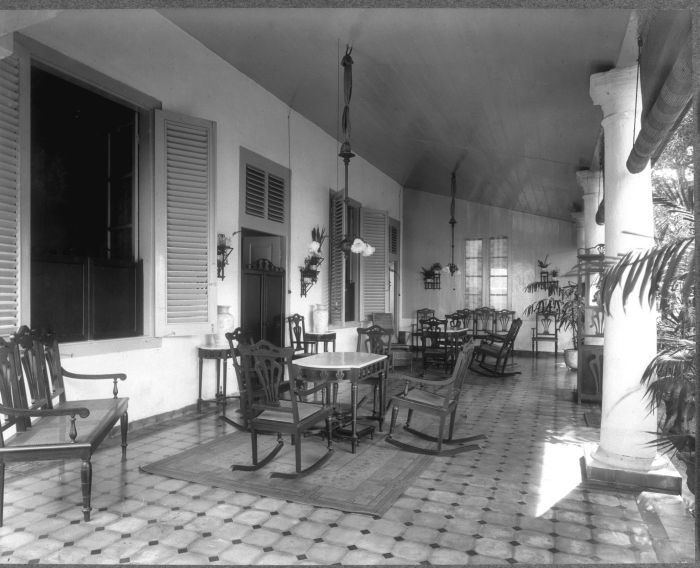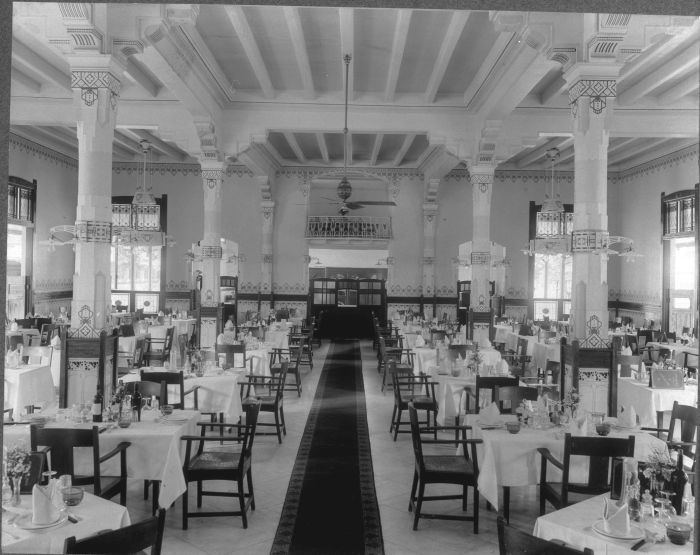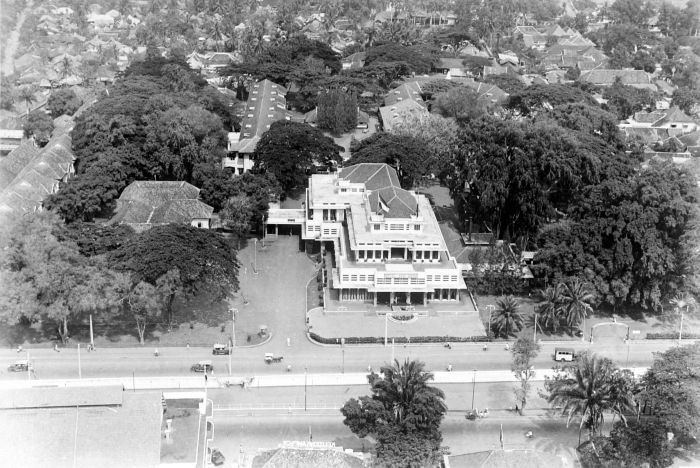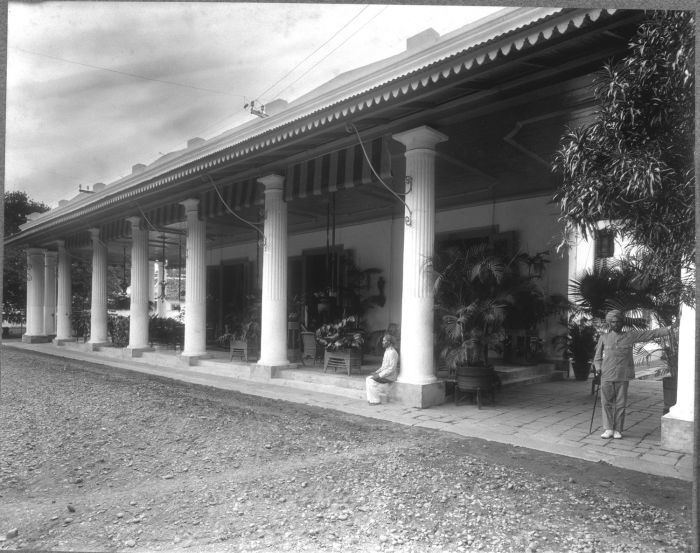 | ||
Similar Merdeka Square - Jakarta, Hotel Des Indes - a Luxury C, Savoy Homann Bidakara, Ikada Stadium, National Archives Building | ||
Hotel des Indes was one of the oldest and most prestigious hotels in Asia. Located in Batavia, Dutch East Indies (modern day Jakarta, Indonesia), the hotel had accommodated countless famous patrons throughout its existence from 1829 to 1971. Before being named Hotel des Indes, a name suggested by the writer Multatuli, it was named ‘Hotel de Provence’ by its first French owner and for a short spell went by the name ‘Hotel Rotterdam’. After Indonesian independence it was renamed ‘Hotel Duta Indonesia’, until it was demolished to make way for a shopping mall.
Contents
- Hotel history
- Hotel de Provence
- Hotel des Indes
- Hotel des Indes during WWII
- Hotel des Indes during the Indonesian Revolution
- Hotel duta Indonesia
- References

This hotel should not be confused with ‘Hotel des Indes’ in The Hague, the Netherlands.
Hotel history

The city Batavia was founded by the VOC and became the main Dutch settlement in South East Asia. In 1747 the Dutch already started to build on the land where later the ‘Hotel Des Indes’ would arise. In 1760 the site was bought by the VOC Governor General Reynier de Klerck.

In 1824, the land was bought by the Dutch East Indies government. In 1828 a boarding school for girls was constructed. However the boarding school was soon abandoned because due to the lack of European females in the Dutch East Indies its teachers kept leaving to get married.
Hotel de Provence

In 1829, the real estate was bought by the Frenchman Antoine Surleon Chaulan (born in 1793 Aubagne, Provence, France) who started a hotel named after his birthplace ‘Hotel de Provence’. At an auction in 1845 Etienne Chaulan bought the hotel from his brother for 25,000 Dutch guilders. Etienne made the hotel famous for being the first to sell different types of European style ice cream.

In 1851 the hotel was bought by Cornelis Denninghoff, who changed the name to ‘Hotel Rotterdam’. Although the hotel was located close to the elite ‘Harmony Society’ and French tailor shop ‘Oger Frères’, it lost prestige and the next year the property was bought by a Swiss staff member named Francois Auguste Emile Wijss, who was married to Antoinette Victorine Chaulan, the 16-year-old daughter of Surleon Chaulan.
Hotel des Indes
On the advice of none other than patron Eduard Douwes Dekker, Wijss changed the name of the hotel to the much more chic-sounding ‘Hotel Des Indes’ in 1856.
In 1860 Wijss sold the hotel to the Frenchman Cresonnier. Louis Couperus, yet another famous writer, became a regular patron. Cresonnier commissioned the famous British photographers Walter Bentley Woodbury (1834–1885) and James Page (1833–1865) to photographically capture the hotel for an advertisement campaign.
Ocean travelers in the 19th century arriving in the port of Batavia were taken to shore with small boats and dropped off at the ‘Kleine Boom’ customs office. They were then taken to ‘Hotel Des Indes’ in a carriage along Molenvliet street. A 19th century visitor described his ride to ‘Hotel Des Indes’ in old Batavia as follows:
“When you ride along Molenvliet the whole scene changes: Gradually you see the nicer and bigger houses, surrounded by ornate gardens. We admire a succession of villas with coconut forests and fruit gardens. We're in that delicious part of Batavia, which is called Rijswijk.
In the morning between eight and ten hours we see the road covered with thousands of vehicles of all kinds carrying men rushing to their offices. Dignified trams are smoothly purring in between them, contrary to the cumbersome wooden carts on two high wheels, drawn by oxen.
In 1869 British anthropologist Alfred Russel Wallace described the hotel's accommodation as follows:
"The Hôtel des Indes was very comfortable, each visitor having a sitting-room and bedroom opening on a verandah, where he can take his morning coffee and afternoon tea. In the centre of the quadrangle is a building containing a number of marble baths always ready for use; and there is an excellent table d'hôte breakfast at ten, and dinner at six, for all which there is a moderate charge per day."
Cresonnier died in 1870 and his family sold the hotel to Theodor Gallas who in turn sold in 1886 to Jacob Lugt for 177.000 Dutch guilders. Lugt greatly expanded the hotel with land purchased from his neighbours. During the economic depression in 1897 Lugt founded the ‘s.a.Hotel Des Indes’ to avert financial liability in case of a potential bankruptcy.
In 1903 the hotel was owned by Gantvoort who eventually made the hotel famous (for instance for its grandiose Rijsttafel) throughout Asia and extremely successful. Under managing director Nieuwenhuys, father of the famous Indo author Rob Nieuwenhuys the hotel paid 25% dividend.
Hotel des Indes during WWII
In 1942 the Japanese seized the Hotel but left Director Mr. G. Hötte, manager since 1938, in charge. The remaining Indo-European staff was permitted to continue their work for over one year before being interned in a Japanese prisoner camp. Commissioners J. Berendsen, A. A. J. de Neef and A. F. Vas Dias were forced to resign and were imprisoned.
Only W. F. Daniels, the general chief of service, who was held in high esteem by the indigenous staff was considered indispensable, until a Japanese hotelier took charge of the hotel. Thereafter the remaining indigenous staff was not treated very cordially, but encouraged by the elder employees they nevertheless remained in service.
In 1942 the future vice-president Mohammad Hatta was temporarily housed in the hotel by the Japanese authorities.
Hotel des Indes during the Indonesian Revolution
After the Japanese capitulation in 1945 the R.A.P.W.I. (Organization for the Recovery of Allied Prisoners of War and Internees, the Initial Headquarters of the Allied Land Forces in South East Asia) took over the hotel and made it a safe haven for returning European refugees. However, during the "Bersiap" period, most of the indigenous staff quit, due to fear of violent reprisals from extremist revolutionaries.
June 1946 ‘Hotel des Indes’ was back in business. G.P.M. van Weel was appointed director, with advisory co-directors, A. and F.J. ZeiIinga, who ensured that for the time being the hotel was fully up and running again. May 7, 1949 the hotel was the historic location of the Roem–van Roijen Agreement that led to the release of Sukarno and Hatta and eventually the Dutch transfer of sovereignty to the Indonesian Republic.
Hotel duta Indonesia
After Indonesian independence in 1949 the hotel was annexed without compensation and the name was changed to ‘Hotel Duta Indonesia’, a name change that continued the abbreviation HDI. In 1958 the hotel still welcomed the likes of American actor John Wayne. Nevertheless, the hotel’s commercial decline commenced, especially after 1962 when the Sukarno commissioned competing ‘Hotel Indonesia’ was inaugurated. The grand old ‘Hotel Des Indes’ was demolished in 1971 to make way for shopping mall ‘Duta Merlin’.
